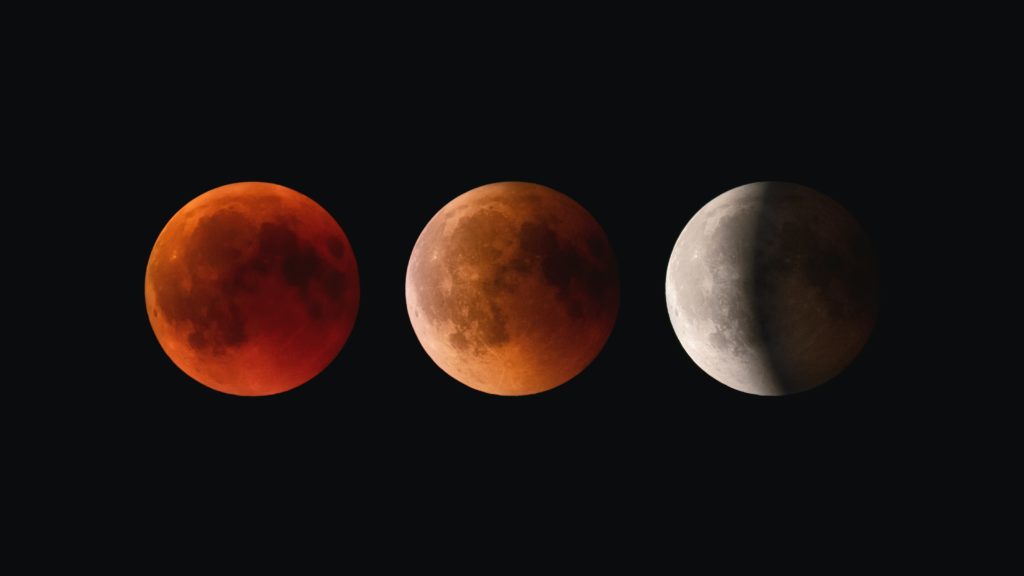
Total Lunar Eclipse
One of the most dramatic and easily viewed celestial events—a total lunar eclipse—is fast approaching. It happens on May 15/16 and will be visible from across North and South America, Western Europe, and Africa. Lowell Observatory will have a great view of the event and will host an in-person eclipse bash and will be staying open until midnight as well as a virtual option that people around the world can join.
Lunar eclipses occur only when the Moon is in its full phase, whereas solar eclipses take place only when the Moon is new. A full Moon happens when it is opposite the Sun, with Earth in between the two bodies. Thus, when the Moon is full, it will be rising on the eastern horizon as the Sun is setting on the western horizon. At full Moon, the Sun, Earth and Moon are close to being in a straight line. But, sometimes the alignment is almost perfect and the Moon passes through the shadow of the Earth. The result of this is a darkening of the Moon, or a lunar eclipse. The deeper into the shadow the Moon moves, the greater the eclipse. If the entire surface of the Moon moves into shadow, then a total lunar eclipse occurs.
Viewing the May Eclipse
During a lunar eclipse, Earth’s shadow consists of two parts. The penumbra is the lighter, outside portion of the shadow and in Flagstaff—where the eclipse will play out entirely on May 15—it will be present when the Moon rises at 7:15pm (all times listed here are for Flagstaff, MST) though it’s faint and difficult to see. The umbra is the darker, central part of the shadow. Its appearance is far more prominent and, for most people, indicates the true beginning of the eclipse. It will appear at about 7:27pm. This shadow will enlarge and pass across the Moon until 8:29pm, when the Moon will be completely in the shadow of Earth and thus totally eclipsed. Totality will last 84 minutes, ending at 9:53pm. The Moon will then slowly brighten as the shadow continues to migrate, until 10:57pm when the umbra disappears. This indicates the end of the eclipse as most people think of it, though the faint penumbra will still be present until 11:50pm.
The eclipse will be easy to view (if clouds don’t obscure the view) since no special equipment is needed. However, binoculars or a telescope will still offer a fascinating view, revealing craters, mountains, and other features moving in and out of Earth’s shadow. Lowell Observatory’s eclipse party on May 15 will celebrate the entire event, allowing onsite guests to view the eclipse through telescopes, hear a variety of science programming, and enjoy other activities planned for the evening. Guests joining virtually will see views captured with one of the PlaneWave telescopes housed at the Giovale Open Deck Observatory an also join in on discussions. For the latest news about these events, check the Lowell Observatory web site at www.lowell.edu.
Some Lunar Eclipse History
Chinese observers apparently made the first written record of a lunar eclipse in 1136 B.C., though eclipse mythology existed hundreds of years before this. Most early explanations for the phenomenon were absurd in the light of modern science. Monsters and spirits of various forms were frequently blamed. In around 520 B.C., the Greek philosopher Anaxogoras revealed the true cause. For his troubles, he was labeled an atheist and thrown in jail.
Later lunar eclipse watchers noticed Earth’s shadow was crescent-shaped, proving that Earth is spherical. If it was flat, its shadow could not be crescent-shaped but would instead be straight. Seafarers also found eclipses of use, for a time using them to determine longitude. They thus often carried on board ship almanacs that included dates and times of eclipses, among other things.
This data came in handy for Christopher Columbus, who used his knowledge of an upcoming total lunar eclipse to settle a dispute with native Jamaicans. On Columbus’s fourth voyage to the New World, in 1504, he and his crew were stranded on Jamaica for more than a year. A feud between the crew and natives developed, and Columbus knew he had to settle it before lives were lost. Columbus knew that a total lunar eclipse would occur on March 1. That night, he gathered the natives and told them that the “Almighty” was going to take away their Moon because of the natives’ poor relations with the sailors. Later, as the Moon was eclipsed, the natives apparently were horrified and begged for forgiveness, promising to be friendly if only the Moon was returned. Thus appeased, the Almighty “retuned the Moon” and peace was restored.
While there is no mystery today about the true nature of eclipses, they are still enjoyable to watch and worth making the time to see.
Want stories like this delivered directly to your inbox each month?
Kevin Schindler, Historian & PIO, is a published author of 7 books and is the historian and Public Information Officer at Lowell Observatory. He also contributes a bi-weekly astronomy column to the Arizona Daily Sun newspaper.